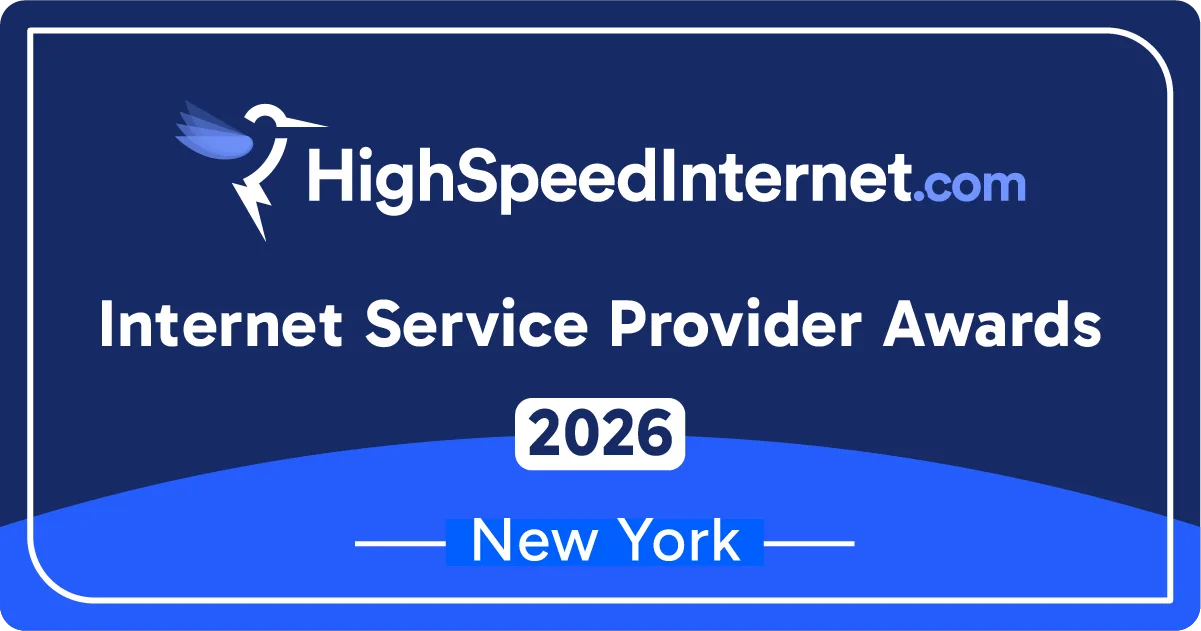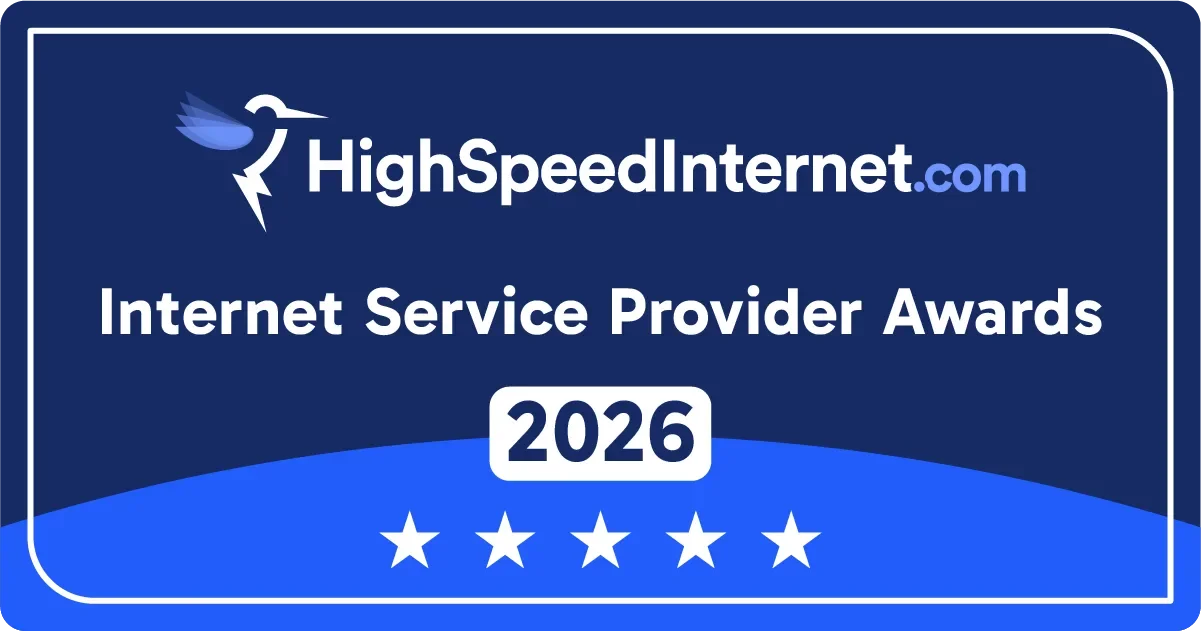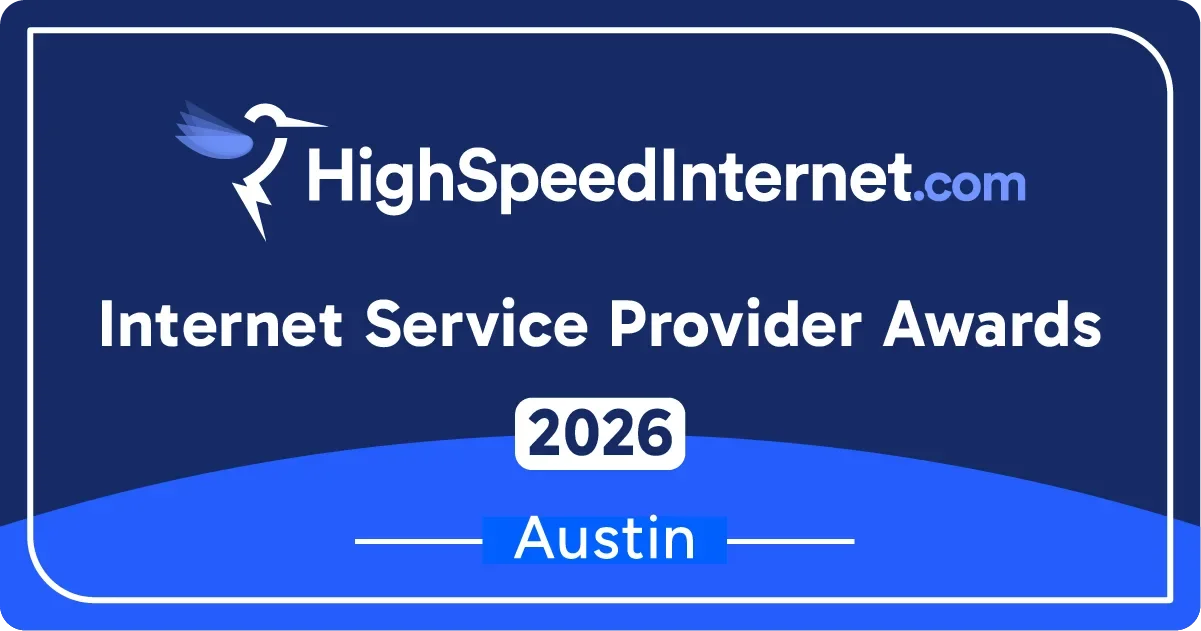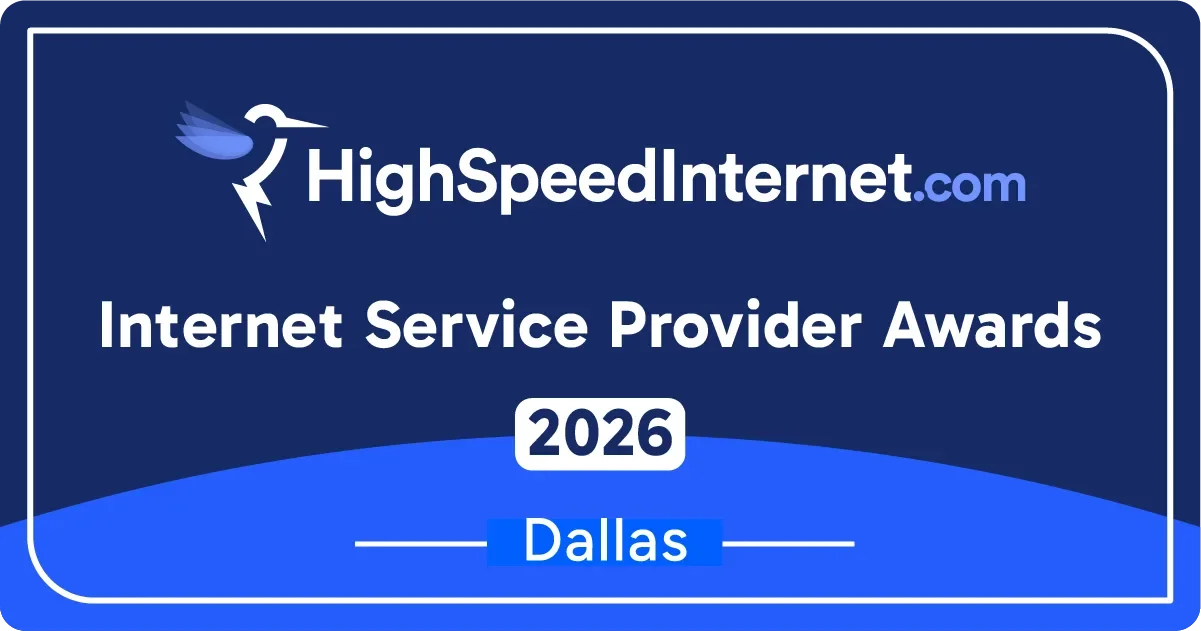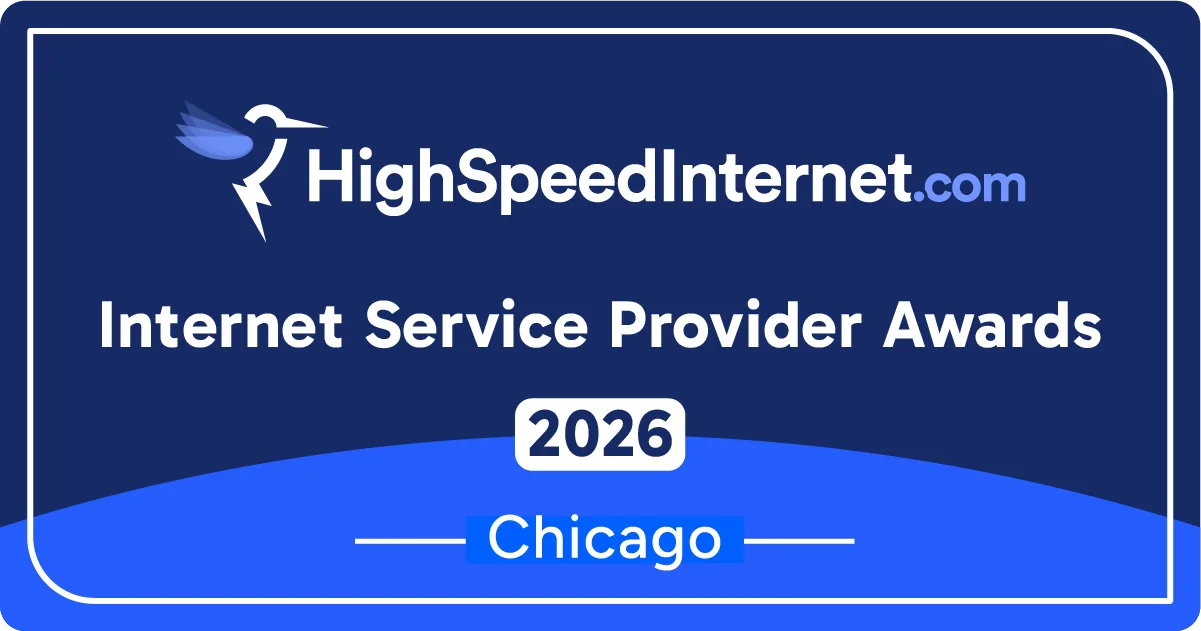Internet Access for Students in Utah
Internet resources and tools to help keep K-12 students on track
Aug 25, 2025 | Share
Data and Research, Trends
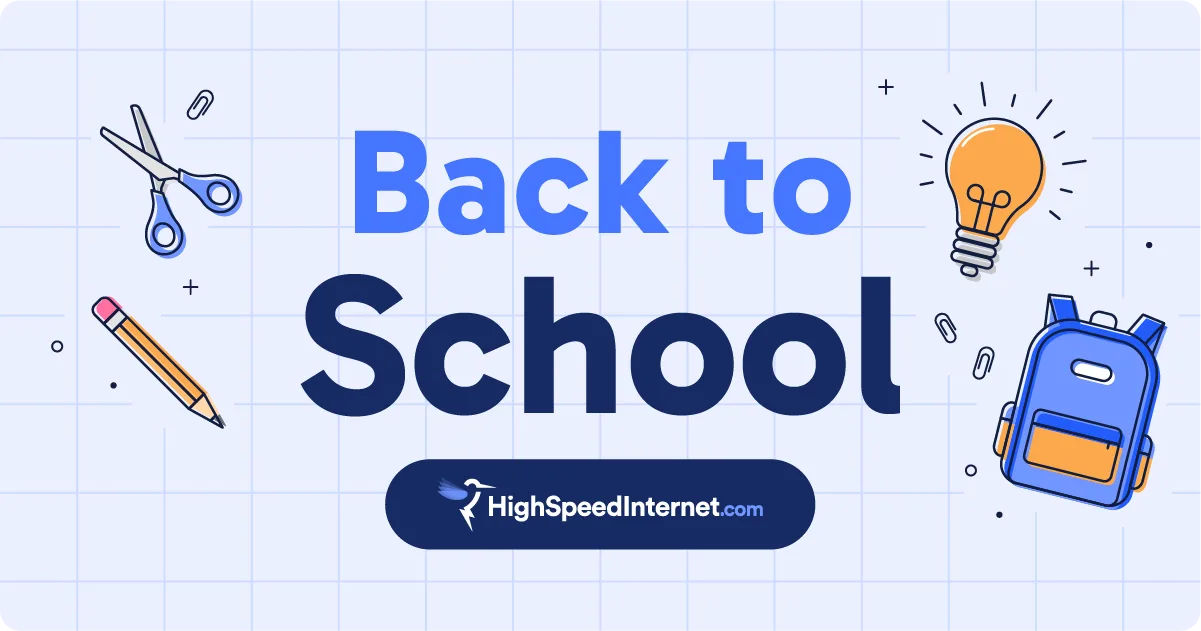
It’s back-to-school season! But does your family know how much internet bandwidth your student will need this year? Students will need access to enough speed to join Zoom study groups, use online learning tools, and finish last-minute homework assignments.
A majority of K-12 students are using cloud-based tools while 63% of students in the US engage in online learning activities daily.

Parents are often given lists for specific back-to-school supplies, yet schools don’t often highlight or supply internet requirements for families. And with a lack of statewide guidance, often, families must guess at their internet needs—and sometimes overpay for internet service.
Students without access to enough internet may ultimately feel left behind. In addition, parents may need to upgrade their plans, leading to surprise budgeting changes.
We’ll break down the state of internet access in Utah across school districts, the hidden problem of lack of authoritative guidance, and helpful resources including the handy HighSpeedInternet.com free speed test and app (Apple App Store / Google Play Store).
What speeds are needed for basic K–12 tasks?
Homes with students should have a broadband connection with at least 100Mbps download and 20Mbps upload speeds. To determine how much speed you need, reserve 25Mbps in download speed for each student in your home followed by all the other devices you use.
Download speeds are the most important, but upload speeds also affect things like Zoom call quality and reliability. Your student’s internet needs will vary by curriculum (i.e. media-focused classes may involve higher bandwidth requirements).
For light applications, a 2Mbps download minimum threshold might work for students, but lower speeds risks lag, poor video quality, and slow-loading educational tools that lead to delays and distractions.
Of course, higher speeds typically come with higher costs, and not everyone has access.
The State of Internet Access in Utah
Did you know? In Utah, roughly 26,000 households do not have a computer at their home, and 70,000 do not have an internet subscription. (Source: U.S. Census Bureau)

Analyzing Census data, we see that Utah’s digital divide mirrors its income divide: Lower-income households are disproportionately without internet subscriptions (limiting students’ ability to access online learning), and higher-income households are far more likely to be connected.
One in five households with an income less than $20,000 are without an internet subscription. Whereas, 8% of households making up to $75,000 annually lack internet access, and households making $75,000 or more a year are virtually all connected.
| Income bracket | % w/o an internet subscription |
|---|---|
| Less than $20,000 | 21.5% |
| $20,000–$74,999 | 8.1% |
| $75,000 or more | 2.5% |
When it comes to internet speeds and plan pricing, Utahns are getting a worse-than-average speed for a much higher cost compared to the rest of the nation.
Though the Federal Communications Commission (FCC) defines high-speed internet as 100Mbps (see PDF), the national average speed is 214Mbps—and Utah’s average internet download speed is 201Mbps, ranking #13 in the nation. (Source: internal proprietary data based on advertiser rate and internal speed data.)
For those making $20,000 a year, Utah’s average internet prices amount to 6% of their monthly income—but there are programs to help make internet service more affordable or even free.
Read our guide on how much you should be paying for internet to learn more.

Utah’s internet and computer access by school district
According to the U.S. Census Bureau, most school districts in Utah are under 3% without computer access, but cities like Granite (3.1%) and Washington (3.8%) breach that threshold.
And Ogden stands out for having nearly double that threshold: Nearly 5.8% of homes do not have a computer.
Comparatively, Provo has a computer in virtually every home—but it’s a huge outlier for having a high percentage (14.40%) of households with no internet subscription (possibly due to a greater student population reliant on campus internet).
Most Utah districts float somewhere near 4–7% for households without a subscription. Areas like Provo (14.4%), Washington (7.6%), and Granite (6.7%) are on the higher end.
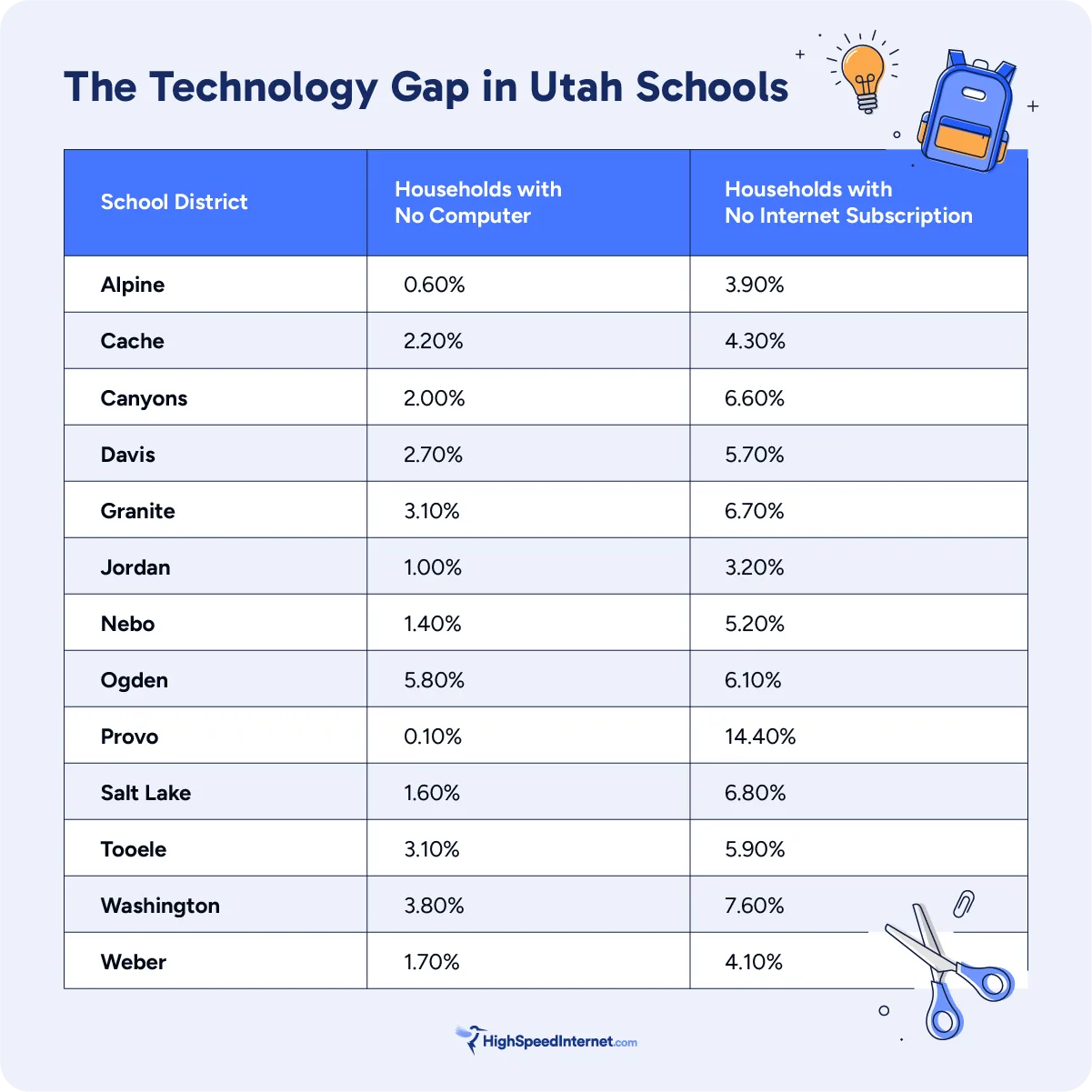
The lack of computers and internet access in the home means students need to use school or library computer labs, borrow and share computers with others, or rely on student Wi-Fi to complete certain tasks and have easier access to information and helpful tools.
That means parents also have to adjust their lives to ensure those requirements are met, and some families simply can’t handle surprise bills and ever-shifting schedules on top of life’s normal burdens.
Highlighting urban vs. rural gaps
Being connected isn’t always enough to keep up, and Utah’s rural citizens are often caught in the digital divide.
As mentioned in our recent report on Utah’s Best and Worst Cities for Internet, Utah’s internet speeds range from Murray’s 370.73Mbps, which is 73% above the national average, to Fillmore’s 48.27Mbps, which falls 77% below the national average, demonstrating the huge internet speed gap across the state.
And rural Utah towns get the raw end of the deal: Helper and Moab residents pay over twice the national average price for speeds less than 100Mbps, and towns like Fillmore, Ephraim, and Fairview pay 50–150% more for speeds slower than 70% than those of Utah’s top-performing cities.
To help incentivize last-mile broadband expansion to unserved rural and underserved economically distressed areas, Utah provides grants based on specific criteria, such as average speeds less than 25Mbps download and 3Mbps upload. These grants are available to telecommunications providers or internet service providers, public-private partnerships, and tribal governments.
Utah’s Internet Access Progress highlights:
- The Utah Education Network (UEN) now supports over 2,000 locations, including public school
- The S. Department of the Treasury increased Last Mile funding in 2024 up to $14,800,000.
- The Utah Broadband Center’s Broadband Access Grant (BAG) and Broadband Infrastructure Grant (BIG) programs have committed over $330 million toward connecting roughly 45,000 unserved or underserved locations by 2030.
In addition to government resources, several companies like Windstream and CenturyLink offer low-income internet, provide special internet deals for students, or create special projects like T-Mobile’s Project 10Million to help bridge the digital divide.
The hidden problem: Lack of guidance
Beyond high costs, subpar speeds, and lack of access, Utah families also face the challenge of knowing exactly what to expect for internet requirements from schools, if they expect them at all. These requirements vary based on a variety of factors, including individual course curriculum.
Schools may make assumptions that every home and child has computer and internet access, and that access is good enough to receive proper education and communications. Without guidance from schools or the state, parents are left to guess at what internet speed is required for a smooth, pain-free education experience for their children.
With expansion for online classes, in forms such as the Statewide Online Education Program (SOEP), along with more shifts toward online learning following, we’d like to see prominent internet information coming from schools and governments to help families. And we also encourage parents to test their internet speeds, rather than guess.
Utah parents: Add this to your back-to-school list
The perfect tool for back to school families: HighSpeedInternet.com’s Speed Test app—a free, quick, and easy way to find out if your internet speeds meet the basic needs for your kids’ education.
Download the app, test your speeds, and see if they hit the basic standard requirements:
- Download speeds: A bare minimum of 2Mbps, with a recommended minimum of 25Mbps. High-speed is considered at least 100Mbps, and Utah’s average speed is 201Mbps.
- Upload speeds: Though upload speeds matter less, the FCC aims for a 3Mbps minimum, and 10Mbps is considered fast—though some plans, like fiber internet, offer equal download and upload speeds.
How clear internet speed standards could benefit Utah households
Too often, parents are left guessing if their home internet can keep up with their child’s education. In fact, a national survey found 36% of Americans don’t know their home internet speed.
Schools rarely spell out the minimum speeds required, and the state doesn’t make those requirements prominently known, or easy to find. Utah families are already paying more than the national average for slower service.
To help Utah families, experts and advocates recommend the following:
- Schools provide every parent with clear, written internet speed guidelines at the start of the year.
- State and local agencies publish baseline speed requirements—especially for rural and low-income households.
- Families take charge: Run our speed test and download the app to see if you meet the 25Mbps recommended minimum, and then use our resources to compare providers in your area to get faster speeds for a better price.
Though there are appropriate use policies and safety guidelines for the internet in schools, there is no publicly available state-level guidance from the Utah State Board of Education detailing required home internet speeds or device compatibility for remote learning. This absence of policy creates inconsistency across districts and leaves families without clear direction.
Access to learning shouldn’t depend on guesswork, or overpriced and underperforming service. By providing families with better internet information, we can eliminate education gaps.
Methodology
We analyzed internet availability, adoption, and affordability in Utah using multiple data sources. Household-level statistics on computer ownership and internet subscriptions came from the U.S. Census Bureau’s American Community Survey (ACS), 2021 one-year estimates (Table S2801). District-level comparisons were calculated from ACS school district data.
National averages and Utah speed benchmarks are based on proprietary HighSpeedInternet.com speed test data and advertiser rate analysis.
We also referenced Federal Communications Commission definitions of broadband (100 Mbps download/20 Mbps upload) and reviewed government programs, including the Utah Broadband Center’s Broadband Access and Infrastructure Grant initiatives.
Author -
Trevor's written professionally for five years for editorial publications and retail/e-commerce sites. He lives in Salt Lake City and enjoys photography and making music in his spare time, or you can catch him on your local dance floor bustin' a move.
Editor - Jessica Brooksby
Jessica loves bringing her passion for the written word and her love of tech into one space at HighSpeedInternet.com. She works with the team’s writers to revise strong, user-focused content so every reader can find the tech that works for them. Jessica has a bachelor’s degree in English from Utah Valley University and seven years of creative and editorial experience. Outside of work, she spends her time gaming, reading, painting, and buying an excessive amount of Legend of Zelda merchandise.



